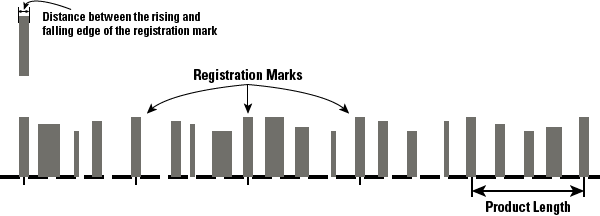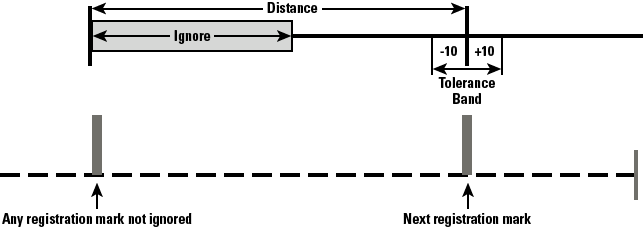Registration Application Guide
In many closed-loop servo systems it is often necessary to maintain synchronization and accurate positioning repeatedly throughout a process. This can be difficult when the product or process itself is inconsistent. Using registration helps you to overcome this difficulty.
Many factors can contribute to inconsistency. Some examples are:
- Working with non-rigid material which may stretch or shrink during processing.
- Working with the mechanics of a system where the revolution of a feedback device
 A process whereby some proportion of the output signal of a system is passed (fed back) to the input.
In automation, a device coupled to each motor to provide indication of the motor's shaft angle, for use in commutating the motor and controlling its speed and position may give you, for example, 5975 counts on one revolution and 5974 on the next.
A process whereby some proportion of the output signal of a system is passed (fed back) to the input.
In automation, a device coupled to each motor to provide indication of the motor's shaft angle, for use in commutating the motor and controlling its speed and position may give you, for example, 5975 counts on one revolution and 5974 on the next. - Unevenly spaced products on a web or belt.
- Materials which are sensitive to temperature, humidity, pressure, etc.
To overcome the various product and process inconsistencies registration capabilities may be required and can be applied on any servo or digitizing axis, and with any move type. Typically in these applications, sensors are used to detect the position of the product. With non-rigid materials, which may stretch or shrink or are unevenly spaced, a photo eye can detect registration marks on the material. With rigid products or processes a proximity sensor![]() A sensor is a type of transducer that converts one type of energy into another for various purposes including measurement or information transfer can detect leading or trailing product edges for material spacing.
A sensor is a type of transducer that converts one type of energy into another for various purposes including measurement or information transfer can detect leading or trailing product edges for material spacing.

With registration, the registration sensor is wired to the fast input![]() The inputs are taken into account at each cycle depending on the system periodicity (for example each millisecond). Under certain circumstances this can be insufficient when more accuracy is needed, or if a quick response is required from the system. To fill the gap, a drive may have some Fast Input connections (generally one or two). When an event happens that triggers a Fast Input (e.g. when a sensor sends a rising edge), the detection of a signal occurs faster (which can be 1000 times more accurate than the system periodicity). Then the timestamp associated with this input can be provided to the IPC to take corrective action on the servo drive
The inputs are taken into account at each cycle depending on the system periodicity (for example each millisecond). Under certain circumstances this can be insufficient when more accuracy is needed, or if a quick response is required from the system. To fill the gap, a drive may have some Fast Input connections (generally one or two). When an event happens that triggers a Fast Input (e.g. when a sensor sends a rising edge), the detection of a signal occurs faster (which can be 1000 times more accurate than the system periodicity). Then the timestamp associated with this input can be provided to the IPC to take corrective action on the servo drive![]() A servo drive is a special electric amplifier used to power electric servo motors. It monitors feedback signals from the motor and continually adjusts for deviation from expected behavior providing the means for the registration trigger that will capture the axis position at the instance of the registration event. When the event occurs, the system will calculate a registration correction to compensate for the inconsistency and then can apply the correction to the registration axis and/or change the numerical representation of the registration axis position.
A servo drive is a special electric amplifier used to power electric servo motors. It monitors feedback signals from the motor and continually adjusts for deviation from expected behavior providing the means for the registration trigger that will capture the axis position at the instance of the registration event. When the event occurs, the system will calculate a registration correction to compensate for the inconsistency and then can apply the correction to the registration axis and/or change the numerical representation of the registration axis position.

This is important in applications such as printing, packaging, and converting where the process must be precisely coordinated and any non-rigid material cannot be depended upon to retain dimensional relationships. These applications usually involve master/slave moves. Not only does registration provide correction but the fast input signals can also be used as repeatable references to which the master and all subsequent slaves continually synchronize. Two main types of registration are Mark to Mark Registration and Mark to Machine Registration.
Mark to Mark Registration
Mark to Mark Registration is implemented with the function block MC_MarkRegist and is based on the desired distance between two registration marks. This distance is used to qualify a “good” mark and then calculate a registration correction. Examples of the different mark to mark registration variations include:
- Clear Lane Registration
- Print Registration
- Product Registration
- Rotary Registration
Clear Lane Registration is the most common type of registration used in industry. A dedicated lane on the material is reserved solely for registration purposes. Only the registration marks in the lane will trigger the sensor and fast input on the servo drive. The distance between one registration mark and the next mark is the basis for registration correction calculations.
Print Registration is less common than Clear Lane Registration. Print registration involves picking out a distinct distance between print features. Here too, this distance is the basis for registration correction calculations. Print registration is used when it is not practical to have a clear lane.
Product Registration uses cycle position where the relationship of the product position in the process cycle is important. Product registration can occur synchronously or asynchronously. In synchronous product registration, products typically flow continuously through the process. Registration will measure and calculate small adjustments required to move each product to the correct position. The distance between products is the basis for registration correction calculations. Asynchronous applications may require the axis to sit and wait for the product to pass the sensor and, when it does, initiate a move and also apply registration correction based on the position of the product.
Rotary Registration is used to maintain a fixed axis position reference point on a rotary axis that has non-integer feedback in one revolution. If the axis position is not adjusted, the actual axis position would walk away from the desired position every revolution because of the non-integer number of feedback units per revolution.
Mark to Machine Registration
Mark to Machine Registration is implemented with the function block MC_MachRegist and is based on a desired target position on a machine axis. Like mark to mark registration, mark to machine registration uses the desired distance between two registration marks to qualify a “good” mark (using Clear Lane, Print, and Product registration). But instead of using the mark to mark length, it uses an axis position as its basis for correction.







